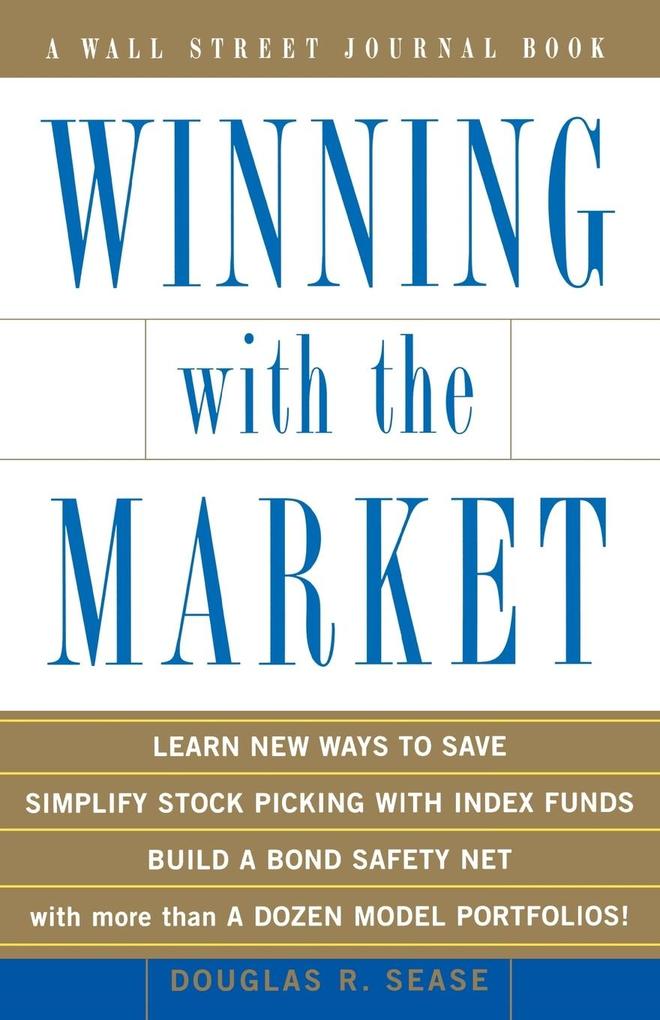
Zustellung: Mo, 14.07. - Do, 17.07.
Versand in 5 Tagen
VersandkostenfreiBestellen & in Filiale abholen:
A lifetime plan for building and maintaining low cost, powerful portfolios, whatever your means and financial goals
Winning with the Market simplifies the investment process, freeing investors from the tyranny of so-called experts who promise huge returns on the latest hot stock, junk bond, or costly mutual fund -- a strategy that has brought both financial and emotional strain to many investors in the volatile markets of recent years. Here, Wall Street Journal veteran Douglas Sease presents a systematic way to think about investment over the course of a lifetime, explaining:
How to save money for investing
Where to make initial investments
When to shift the balance of the holdings in your portfolio
Why your best strategy is to invest with the market -- in the form of stock-index mutual funds and inflation-indexed Treasury bonds
With Sease as a guide, you'll learn how to create a customized portfolio for every stage of your life. He provides nearly two dozen different model portfolios, offering options for a wide range of risk tolerance, income, age, and financial goals. As a journalist who has followed the careers of superstar investors Warren Buffett and Peter Lynch, he recognizes that their achievements lie beyond the reach of most people. With this simple, accessible plan, he makes it possible for ordinary investors to set and reach reasonable goals, making the most of their time and money.
Winning with the Market simplifies the investment process, freeing investors from the tyranny of so-called experts who promise huge returns on the latest hot stock, junk bond, or costly mutual fund -- a strategy that has brought both financial and emotional strain to many investors in the volatile markets of recent years. Here, Wall Street Journal veteran Douglas Sease presents a systematic way to think about investment over the course of a lifetime, explaining:
How to save money for investing
Where to make initial investments
When to shift the balance of the holdings in your portfolio
Why your best strategy is to invest with the market -- in the form of stock-index mutual funds and inflation-indexed Treasury bonds
With Sease as a guide, you'll learn how to create a customized portfolio for every stage of your life. He provides nearly two dozen different model portfolios, offering options for a wide range of risk tolerance, income, age, and financial goals. As a journalist who has followed the careers of superstar investors Warren Buffett and Peter Lynch, he recognizes that their achievements lie beyond the reach of most people. With this simple, accessible plan, he makes it possible for ordinary investors to set and reach reasonable goals, making the most of their time and money.
Inhaltsverzeichnis
Contents
How This Book Will Make You a Better Investor
Part one: Lessons for Long-Term Investors
Chapter 1: Supercharging Your Portfolio with Savings
Tactical Saving
Strategic Savings: Opportunity Costs and Mental Money
Understanding Debt: The Good and the Bad
Making Your Savings Work for You
The Process of Saving
Tory's Portfolios: Stoking Investment Performance with Savings
Chapter 2: Stocks: The Foundation of a Strong Portfolio
Reality Check!
How to Think About Stocks and the Stock Market
The Odds Against You: The Efficient Market Hypothesis
Finding Value in Stocks
Growth Stocks: How High, How Fast?
Narrowing the Field: Market Capitalization
The Myth of IPOs
Foreign Stocks
The Paradox
Chapter 3: Bonds: The Safety Net
How to Think About Bonds
Bond Yields and Bond Prices
Bond Pricing: What You Don't Know Can Hurt You
Calculating Bond Returns
The Bond Menagerie
Building a Bond Ladder
A Word on Treasury Direct
Chapter 4: Money Managers and Mutual Funds
Brokers
Money Managers
Financial Planners
Mutual Funds
Closed-End and Open-End Funds
Money Market Funds
Bond Funds
Stock Funds: Past Performance Is No Indicator of Future Performance
The Simple Solution: Index Funds
Index Fund Alternatives: Exchange-Traded Funds
Part two: Portfolios for Long-Term Investors
chapter 5: Understanding Risk and Return
Working Assumptions
Profit and Pain: Worst-Case Scenarios
Rebalancing
Chapter 6: Getting an Early Start: Portfolios for Long Time Horizons (and Little Money)
The Simple Portfolio
The Flexible Portfolio
Pooled Resources
Dedicated DINKs (Dual-Income, No Kids)
Chapter 7: Getting Serious: Portfolios for Your Thirties
Singles and DINKs in Their Thirties
Escaping the Rat Race
Couples with Kids: The Tuition Target
Chapter 8: Time Is of the Essence: Portfolios for Your Forties
DINKs at Middle Age
You've Got Those Tuition Bill Blues
Chapter 9: Making the Most of Limited Time: Portfolios for Your Fifties
Unlocking Home Equity Values
Chapter 10: Unleashing Your Assets: Portfolios for Retirement
More Strategies for Unlocking Home Equity
Portfolio Summary: Ages 25 Through 65
Epilogue: The Value of Time and Money
An Investor's Tool Kit
The World's Best Index Funds
Setting Up a Treasury Direct Account
rdHow Much Can You Save? The Power of Compounding
How Much Can You Spend? Withdrawing Money in Retirement
Index
Produktdetails
Erscheinungsdatum
01. Juni 2002
Sprache
englisch
Seitenanzahl
224
Autor/Autorin
Douglas R. Sease
Verlag/Hersteller
Produktart
kartoniert
Gewicht
322 g
Größe (L/B/H)
216/140/13 mm
ISBN
9780743204200
Bewertungen
0 Bewertungen
Es wurden noch keine Bewertungen abgegeben. Schreiben Sie die erste Bewertung zu "Winning with the Market" und helfen Sie damit anderen bei der Kaufentscheidung.









